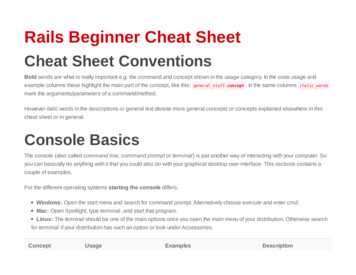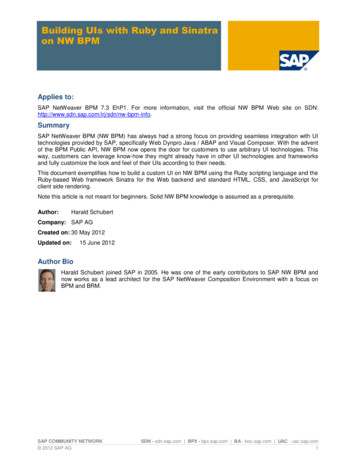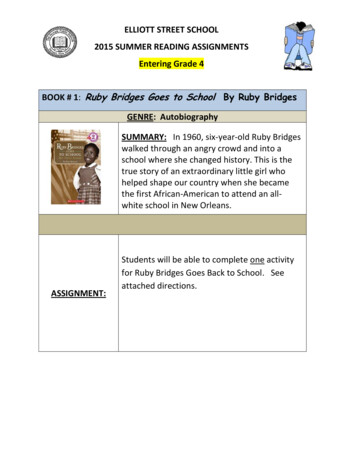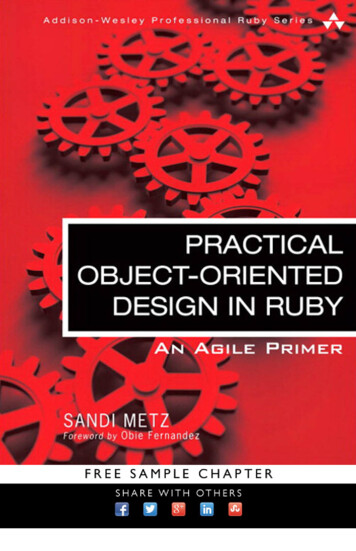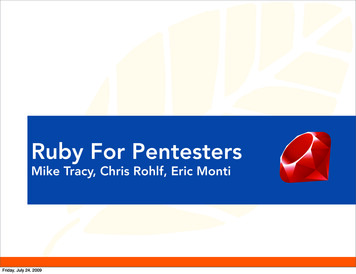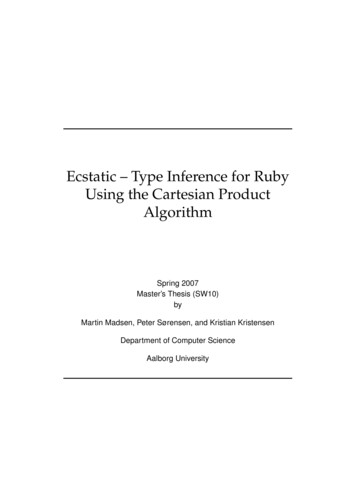
Transcription
Ecstatic – Type Inference for RubyUsing the Cartesian ProductAlgorithmSpring 2007Master’s Thesis (SW10)byMartin Madsen, Peter Sørensen, and Kristian KristensenDepartment of Computer ScienceAalborg University
Ruby, Ruby, Ruby, RubyAhaa-ahaa-ahaaDo ya, do ya, do ya, do yaAhaa-ahaa-ahaaKnow what ya doing, doing to me?Ahaa-ahaa-ahaaRuby, Ruby, Ruby, RubyAhaa-ahaa-ahaa– “Ruby” by Kaiser Chiefs
Aalborg UniversityDepartment of Computer Science, Frederik Bajers Vej 7E, DK-9220 Aalborg EastTitle:Ecstatic – Type Inference forRuby Using the Cartesian ProductAlgorithm (CPA)Project Period:Master’s Thesis (SW10),Spring 2007Project Group:D618AGroup Members:Martin Madsen,epsen@cs.aau.dkPeter Sørensen,ptrs@cs.aau.dkKristian Kristensen,kk@cs.aau.dkSupervisor:Kurt Nørmark,normark@cs.aau.dkCopies:Pages:With Appendices:Finished:7118146June 14th, 2007AbstractThis master’s thesis documents Ecstatic– a type inference tool for the Ruby programming language. Ecstatic is based onthe Cartesian Product Algorithm (CPA),which was originally developed for usein the Self language.The major contributions of this thesis are:the Ecstatic tool that can infer preciseand accurate types of arbitrary Ruby programs. By implementing CPA we confirm that the algorithm can be retrofittedfor a new language. Utilizing RDoc wedevise a method for handling Ruby coreand foreign code both implemented in C.Using Ecstatic a number of experimentswere performed that gained insights intothe degree of polymorphism employedin Ruby programs. We present an approach for unit testing a type inferencesystem. We compare Ruby to Smalltalkand Self, and conclude that their semantics are similar.
SignaturesMartin MadsenPeter SørensenKristian KristensenIII
Contents1Introduction2Ruby and Dynamic Object Oriented Languages2.1 Ruby . . . . . . . . . . . . . . . . . . . . . . . . . . . . .2.1.1 Classes and Objects . . . . . . . . . . . . . . . . .2.1.2 Methods and Messages . . . . . . . . . . . . . .2.1.3 Modules and Mixins . . . . . . . . . . . . . . . .2.1.4 Core Classes and Modules . . . . . . . . . . . . .2.1.5 Attributes and Dynamic Programming . . . . .2.1.6 Code Blocks . . . . . . . . . . . . . . . . . . . . .2.2 Programming Languages Similar to Ruby . . . . . . . .2.2.1 Historical Background and Language Relations2.2.2 Language Similarities and Discussion . . . . . .2.3 Summary . . . . . . . . . . . . . . . . . . . . . . . . . . .5578910111314151522Understanding Types and Type Inference Algorithms3.1 Definition of Types and Related Concepts . . . . .3.1.1 Types in Ruby . . . . . . . . . . . . . . . . .3.1.2 Polymorphism . . . . . . . . . . . . . . . .3.1.3 Type Checking . . . . . . . . . . . . . . . .3.1.4 Type Inference . . . . . . . . . . . . . . . .3.2 The Hindley-Milner Algorithm . . . . . . . . . . .3.3 The Cartesian Product Algorithm (CPA) . . . . . .3.4 Summary . . . . . . . . . . . . . . . . . . . . . . . .232324262728293143Problem Statement4.1 Hypotheses . . . . . .4.2 Goals . . . . . . . . . .4.3 Challenges . . . . . . .4.4 Requirements . . . . .4.5 Quality Requirements4.6 Usage Scenarios . . . .4.7 Summary . . . . . . . .4545484849505152Implementation of Ecstatic5.1 The Type Inference System . . . . . . . . . . . . . . . . . . . . . . .53533451.V.
CONTENTS5.25.35.45.55.66785.1.1 System Overview . . . . . . . . .5.1.2 RubySim . . . . . . . . . . . . . .5.1.3 Parsing Ruby . . . . . . . . . . .5.1.4 The Controller . . . . . . . . . . .Methods and Templates . . . . . . . . .5.2.1 Optional Arguments . . . . . . .5.2.2 Propagation Through TemplatesKeeping Track of self . . . . . . . . . .Types and Grouping . . . . . . . . . . .The State of Ecstatic . . . . . . . . . . . .Summary . . . . . . . . . . . . . . . . . .Testing Ecstatic6.1 Research on Compiler Validation6.2 Relation to Type Inference . . . .6.3 Validation Suite . . . . . . . . . .6.3.1 Test Suite Framework . .6.3.2 Results . . . . . . . . . . .6.3.3 Reflection . . . . . . . . .6.4 Summary . . . . . . . . . . . . . s7.1 Data Collection . . . . . . . . . . . . . . . .7.2 Results . . . . . . . . . . . . . . . . . . . . .7.2.1 Use of Variables . . . . . . . . . . . .7.2.2 Use of Instance Variables . . . . . .7.2.3 Degree of Parametric Polymorphism7.2.4 Running Time . . . . . . . . . . . . .7.2.5 NoMethodErrors . . . . . . . . . . . .7.3 Data Critique . . . . . . . . . . . . . . . . .7.4 Summary . . . . . . . . . . . . . . . . . . . .89919292949595959697Discussion8.1 Experiences With the Ruby Language8.1.1 Implementing Blocks . . . . . .8.1.2 Dynamic Programming . . . .8.2 Discussion of the Hypotheses . . . . .8.3 Experiences Gained . . . . . . . . . . .8.3.1 Goals . . . . . . . . . . . . . . .8.3.2 Challenges . . . . . . . . . . . .8.3.3 Requirements . . . . . . . . . .8.3.4 Quality Requirements . . . . .8.3.5 Usage Scenarios . . . . . . . . .8.4 Summary . . . . . . . . . . . . . . . . .9999100101103106106106107108108109VI.
CONTENTS9Conclusion111Bibliography112A Acronyms119B RDoc Extractor121C Sample Unit Test125D ExperimentsD.1 BMConverter . . . . . . . . . .D.2 Canna2Skk . . . . . . . . . . . .D.3 e . . . . . . . . . . . . . . . . . .D.4 FreeRIDE . . . . . . . . . . . . .D.5 ICalc . . . . . . . . . . . . . . .D.6 Markovnames . . . . . . . . . .D.7 Quickey . . . . . . . . . . . . .D.8 Roman . . . . . . . . . . . . . .D.9 Projects with Error Conditions .VII.127127132134135137139141143145
CHAPTER1IntroductionRuby is a dynamic programming language, and therefore defers as many decisions as possible to runtime. Dynamic programming languages tend to have ahigh degree of flexibility and expressiveness. These factors makes a languagelike Ruby preferred by some programmers.Although Ruby has existed since 1995, it is still relatively new to the Westernworld and almost unknown to the academic world. The language comes fromJapan and most of the early documentation was in Japanese. Since then English resources have slowly emerged. With the release of the Ruby on Rails webframework in 2004 the language have gained more attention, and subsequentlymany books have been published. O ’Reilly (a publisher of technical books)publishes a book sales list every quarter. Sales of Ruby books have increased inthe last years, and surpasses the sales of languages like Perl and Python.TIOBE Software [55] publishes a list once a month of the most popular programming languages. Their list from June 2007 places Ruby on a 10th place. They havestatistics from June 2002, and Ruby has featured growth since then.Sun Microsystems support a project called JRuby [49] and Microsoft’s has prereleased IronRuby [50]. The projects implement the Ruby language on the JavaVirtual Machine (JVM) and the Common Language Runtime (CLR), respectively.These two announcements illustrate the increasing momentum behind Ruby.After visiting RailsConf 2007, Thorup [54] notes his impression of the adoptionof Ruby. By his observation, Ruby is primarily used in start-up shops and inPHP shops wanting to switch to Ruby on Rails Hansson [28]. He believes thatthe reason is primarily, that developers in these companies are more free to maketechnology choices compared to big companies.The nature of dynamic programming languages often require their programsto be type checked dynamically. A dynamic type check happens at runtime.This implies that a programmer must run a program to get any feedback aboutits behaviour and possible errors. The need to constantly run the program whileprogramming is undesired for several reasons. Furthermore, feedback from running a program is often limited and only covers part of the code.Additional and possibly better feedback can often be provided by analysing thecode statically. One aspect of static code analysis is type inference, in which1
Chapter 1. Introductiontypes are ascribed to variables, expressions, etc. in the code. Utilizing typeinference, the programmer can get valuable feedback on how types flow throughthe program and, thus, discover errors or wrong behaviour before runtime.This thesis couples the field of type inference and the Ruby programming language to create tool that does type inference. The developed tool is called Ecstatic and it uses the Cartesian Product Algorithm (CPA) to analyze the typesand their flow through a Ruby program. Ecstatic is used to conduct a numberof experiments on real life Ruby programs. These experiments form the basis ofa discussion of the value of type inference on Ruby and our developed tool.In the following two sections we present the contributions of this thesis.Major ContributionsEcstatic: We have implemented a tool that performs type inference on Rubyprograms using the Cartesian Product Algorithm (CPA).CPA Works on Ruby: We have implemented CPA to work on Ruby programs.The CPA was developed for use on the Self programming language, so itwas not immediately apparent that it would work on Ruby.Experiences in Implementing CPA: We have gained a number of insights andconsiderable experience in implementing CPA on Ruby. Some of thesedetails and concepts are not readily available in Agesen [1]’s work on CPA.Foreign Code Inclusion: We present a method for extracting type informationfrom the Ruby Core’s RDoc. This enables us to perform more precise typeinference, because we are aware of the types of the built-in libraries.Experiments on Ruby Code: With Ecstatic we have conducted a number ofexperiments on Ruby programs found at the Ruby Application Archive(RAA). This enables us to collect a set of statistics on how Ruby programsare written, including statistics on data and parametric polymorphism.Testing a Type Inference (TI) System: Based on compiler validation, we presenta method for testing the type inference system. The tests are based onRuby source code samples and unit tests based on an extension to JUnit.Comparing Ruby, Self, and Smalltalk: We perform a language comparison between Ruby, Self, and Smalltalk. We conclude that the three languages arevery similar on a semantic level. Although the similarities between Ruby,Self, and Smalltalk are often presented, a more thorough comparison hasnot been done before.2
Minor ContributionsIdeas for Future Research: We present four hypotheses regarding Ruby programs and programmers. Three of these are considerably broad, and arehence not confirmed or rejected in this thesis. However, they can be considered ideas for future work and research.Types in Ruby: We present a suggestion on how to understand types in Ruby.There are different views on this, and we compare these views from a typeinference angle.OutlineChapter 2 gives an overview of Ruby as a programming language. The purposeis to give the reader an intuitive understanding of Ruby. Furthermore a comparison between Smalltalk, Self, and Ruby is performed. Focus is placed on thesemantic similarities and differences between the three languages.Chapter 3 presents the field of type inference. This includes a definition anddiscussion of types and how they are understood, as well as a description oftwo type inference algorithms: the Hindley-Milner algorithm and the CartesianProduct Algorithm (CPA).Chapter 4 establishes a set of hypotheses that constitute the motivation for thisproject. This is supplemented by a list of requirements for the development of atype inference tool for Ruby called Ecstatic.Chapter 5 describes the implementation of the tool using CPA as algorithm. Focus is placed on conveying the experiences gained in implementing CPA andretrofitting it from the Self language to Ruby.Chapter 6 discusses the relation between compiler validation and testing a typeinference system. It also documents the development of a validation suite forEcstatic, and the results obtained from testing Ecstatic using the suite.Chapter 7 performs a set of experiments offset in the hypotheses described inChapter 4. The experiments are conducted using Ecstatic.Chapter 8 discusses the obtained experiment results, experiences gained in implementing CPA, contributions from this thesis, and finally confirms or rejectsthe hypotheses.Chapter 9 concludes the thesis.Acronyms are listed in Appendix A.3
Chapter 1. Introduction4
CHAPTER2Ruby and Dynamic Object Oriented LanguagesAt a panel discussion hosted by MIT’s Dynamic Languages Group in 2001 Steele[51] stated,A dynamic language is one that defers as many decisions as possibleto runtime.In a colloquial way this quote summarizes what dynamic languages are about.The following elaborate on what it means in practice. Ultimately languages arecalled dynamic because they perform many operations at runtime that otherlanguages perform at compilation time. An example of the dynamic nature ofthese languages is that programs can evolve and change as they are running. Ina dynamic object oriented language this can imply the ability to extend objectsand class definitions during program execution. E.g., they can be extended byadding new methods, changing methods, or changing the superclass of a class.Some of these capabilities are available in other non-dynamic languages as well,but the dynamic languages have direct support for it built-in.Since a program written in a dynamic language can change at runtime, the types(or classes) can change too. This can require the language to be dynamically typechecked. Dynamic type checking is discussed further in Chapter 3.This remainder of this chapter describes Ruby – an object oriented language– via code examples. Following this discussion Section 2.2 describes how Rubyrelates to more academically well-established languages like Smalltalk, Self, andPython. This comparison is performed, because previous work done in the typeinference field was based on these languages. The comparison will be based onthe semantics of the languages and not on the syntactical constructions they use.2.1RubyIn this section we describe the parts of the Ruby programming language that wefind most relevant in a type inference context. Furthermore, some basic Rubyis explained to enable the reader unfamiliar with Ruby to understand the code5
Chapter 2. Ruby and Dynamic Object Oriented Languagesexamples presented throughout the report. For a more thorough documentationwe refer to Thomas et al. [53].The description will follow a “Show, don’t tell”-approach popularized in theRuby world by David Heinemeier Hansson – the author of the Ruby on Railsframework. Hence, emphasis will be placed on code examples, instead of moretheoretical explanations. The overall purpose is to give the reader an intuitiveunderstanding of the Ruby programming language.Ruby is a dynamic object-oriented programming language. Its type system iscommonly referred to as Duck Typing the concept of which is summarized inthe following quote known as the duck test:If a bird looks like a duck, swims like a duck and quacks like a duck,then it is indeed a duck [64].This implies that in Ruby, classes are not the way to distinguish one object fromanother, i.e. the class is not the type in Ruby as it is in languages like Java.Instead, if a Ruby object possess the characteristics required by a caller, then forall intents and purposes it is what the caller wants it to be. A more theoreticaldefinition of duck typing is provided in Section 3.1.1.A table presenting the Ruby variable naming scheme is seen in Table 2.1. Itutilizes the code example seen in Listing 2.1. In general, the first two charactersof a name help Ruby and developers distinguish its use.Variable TypeLocal variablesInstance variablesClass variablesGlobal variablesConstantsCharacteristicsStart with a lower case letter or an underscore(line 1 and 2)Start with an “at” sign (@) (line 3)Start with two “at” signs (@@) (line 4)Start with a dollar sign “ ” (line 5)Start with an uppercase letter (line 6). Namesof classes and modules are constants (line 810)Table 2.1: Ruby’s naming scheme with complementary code example in Listing 2.1. 1234567 local varlocal var@instance var@@class var global varMyConstant6
2.1 Ruby8910class MyClass# class bodyend Listing 2.1: Ruby’s naming scheme. The different variables are explained inTable 2.1Variables in Ruby does not need to be defined before used. If you need a variableyou start using it. Often variables are defined assigning to them using an equalsign.2.1.1Classes and ObjectsIn Ruby almost everything is modelled as objects. For example a class definitionis an object being an instance of the core class Class.A class definition in Ruby is shown in Listing 2.2. 123456789 class NewClass SuperClassdef initialize# constructor bodyend# class bodyendobj NewClass . new Listing 2.2: A class definition. NewClass inherits from SuperClass.The SuperClass definition is optional and defaults to the core class Object described later. The class constructor is named initialize and is optional. In line9 an instance of the class is created and assigned to the local variable obj.In Ruby class definitions are executed, and Listing 2.3 gives an example of this.This examples also demonstrates some of the dynamic characteristics of Ruby. 12345678910111213 a -8class NewClassif a 0 thendef my method# do one thingendelsedef my method# do another thingendendend7
Chapter 2. Ruby and Dynamic Object Oriented Languages14151617181920212223242526272829obj NewClass . newobj . my methodclass NewClassdef my method# redefinition of my method to do something elseenddef my second method# this method is added to NewClassendendobj . my methodobj . my second method Listing 2.3: Definitions are executed, which make for interesting use cases.If the value of a is less than 0 at the time NewClass is defined, my method will bedefined as in lines 5-7. If the value of a is more than or equal to 0, my method willbe defined as in lines 9-11.In line 18 the definition of NewClass is reopened. my method is redefined in lines19-21, and a new method is added to the class in line 23-25.The object obj, which was instantiated in line 15, now features a new definitionof my method in line 28 and the newly added my second method in line 29. This isbecause calling methods uses dynamic dispatch (the method to invoke is locatedat runtime based on the receiver) and is implemented as messages in Ruby.2.1.2Methods and MessagesWhat looks like a regular method call in the code above is actually a message being sent to that object. The syntax is receiver.message or receiver.message()or just message. The part before the dot (.) is the receiver of the message, and thepart after the dot is the name of the message. The parenthesis after the messageare optional. If the receiver part is omitted, and only a message name is presentthe message is sent to self.When sending a message to an object, the object checks if it has a method matching the name of the message. If it does that method is invoked and the result isreturned. If it does not the message is forwarded to the class of the object. Thesame check goes on at the class level, and if not implemented here, the messagewill be forwarded to any ancestors of the class. If no ancestor of the receiver implements a method with the name of the message, the exception NoMethodErroris raised. This process is known as duck typing.8
2.1 RubyA method returns the value of the last expression evaluated in the method body.This is often just the last line of code. One can also use an explicit return.Methods can be defined in three different ways as displayed in Listing 2.4. 123456789101112131415161718192021 class NewClassdef instance method# method bodyenddef NewClass . class method# method bodyendendobj NewClass . newdef obj . singleton method1# method bodyendclass objdef singleton method2# method bodyendend Listing 2.4: Defining methods.Line 2 defines a normal instance method on a class, which is accessible after theclass is instantiated.Line 6 defines a class method by prepending the name of the class being defined(in this case NewClass) to the method name. A class method is accessible directlyfrom the class just like static methods in Java.Line 13-15 and 17-21 shows how singleton methods can be defined. The twosingleton methods exist only on the object obj and do not affect NewClass. Ifa second object was instantiated from NewClass it would not have the methodssingleton method1 and singleton method2. The singleton method definitionin line 13 prepends the name of the object it is created on, which resembles thesyntax of the class method definition in line 6.The syntax in line 17-18 is different. In line 17 a special virtual class (called asingleton class, see Section 2.2.2) of obj is opened and in line 18 a method isinserted into that class, which makes the method a singleton method of obj.2.1.3Modules and MixinsModules are classes that cannot be instantiated. A module definition basicallyresembles a class and can contain the same elements as a class definition. Asthe name “module” indicates it is a wrapper for grouping functionality. This9
Chapter 2. Ruby and Dynamic Object Oriented Languagesfunctionality can be used directly from the module or by mixing it into a class.Listing 2.5 shows an example. 123456789101112131415161718 module NewModuledef method1# method bodyendendclass NewClassinclude NewModuledef method2method1endendobj NewClass . newobj . method1obj . method2 Listing 2.5: Modules and mixinsLine 1-5 defines a module with an instance method method1 in line 2. method1is similar to an instance method, and is not yet accessible in any way, becausemodules cannot be instantiated. In line 8 the NewModule is mixed into the classNewClass by calling include. The method of NewModule is now available inNewClass. NewClass can therefore define a method2 in line 10 that calls method1in line 11. Both methods can be called from an instance of NewClass in line 17-18.2.1.4Core Classes and ModulesThe core of Ruby is implemented in C and has 34 classes and 14 modules. Mostof the classes include one or more modules as mixins. The base class Objectincludes the module Kernel and this class and module provide much of thebuilt-in functionality of Ruby.Basic functions in Ruby are implemented as methods. For example, the functionputs that prints to standard output is a method defined on Kernel. The “helloworld” example looks like this in Ruby:puts "Hello World!"puts is a message sent to self. self in global space is an object called main,which is an instance of Object. The message puts is thus sent to main, which10
2.1 Rubyforwards it to its class Object, which forwards it to its included module Kernel.The general order of method lookup is:1. The class of the receiver2. Any included modules of the receiver class3. The superclass of the receiver class4. Any included modules of the superclass5. The superclass’s superclass6. And so on. . .If an object gets singleton methods these lookup rules are still valid. However, the immediate class of the receiver may change, which is described in Section 2.2.2.In Ruby, primitive types are classes. A string literal is an instance of the coreclass String. A small integer literal is an instance of Fixnum, and a big integerliteral is an instance of Bignum. Both Fixnum and Bignum inherit from the coreclass Integer. Likewise a float literal is an instance of Float. Both Integer andFloat inherit from the class Numeric. In this way every kind of data in Ruby isan instance of a class.2.1.5Attributes and Dynamic ProgrammingIn Ruby instance variables of a class are always private to that class. To accessthem from outside the class, you must make attributes for them. An example ofattributes is shown in Listing 2.6. 123456789101112131415161718 class NewClassattr reader : readonly varattr writer : writeonly varattr accessor : readwrite vardef initialize@readonly var 1@writeonly var 2@readwrite var 3endendobj NewClass . newputs obj . readonly varobj . writeonly var 5obj . readwrite var 10puts obj . readwrite var11
Chapter 2. Ruby and Dynamic Object Oriented Languages Listing 2.6: Attributes in RubyNewClass has a constructor that initializes three instance variables in lines 7-9.Attributes for these variables are created in lines 2-4. In many other programming languages, attr reader, attr writer, and attr accessor would be language keywords. In Ruby they are methods defined on the Module class, andthereby accessible to all classes. In line 2, a message attr reader with the argument :readonly var is sent to self. :readonly var is an instance of the coreclass Symbol. attr reader creates a read-only method on NewClass with thename of the Symbol argument, which makes the instance variable with the nameof the Symbol available for access in line 15. attr writer correspondingly creates a write-only method. attr accessor creates both a read-only and a writeonly method.The three attribute methods (attr reader, attr writer, and attr accessor)utilizes Ruby’s dynamic programing features to create the methods that wrapsthe instance variables on the class. This concept is also referred to as meta programming because you program the language. 1234567891011121314151617 class MyClassdef initializeenddef my reader ( name )MyClass . class eval - INJECTED CODEdef #{name}()return " you called #{ name }"endINJECTED CODEendendx MyClass . newx. my reader (: hello )puts x. hello ()# outputs: you called hello Listing 2.7: Adding a method to a class dynamically using class evalListing 2.7 shows an example that uses the meta programming features of Rubyto create something similar to attr reader. The example declares a methodnamed my reader, an instance method defined on MyClass, which takes a singleparameter name. Calling my reader adds a method to the class MyClass withname as the method name. This method returns “you called” and the name ofthe method.Line 6 calls class eval on MyClass with a HERE document (basically a string) asparameter delimited with INJECTED CODE. The string contains a normal method12
2.1 Rubydefinition and uses #{name} to access the method name. class eval evaluatesits given parameter in the context of a class. So the result of calling this methodis that MyClass and all instances of it will have a newly declared method. Line 15calls my reader with a symbol :hello. Line 16 calls the newly defined methodand outputs the return value, resulting in you called hello to be printed to theconsole.There are four different eval methods in Ruby, and the difference between themare basically in what environment they are evaluated, i.e. what self is. The fourmethods are, eval, class eval, module eval, and instance eval. class evaland module eval are synomynous and evaluate with respect to a class or module, and are often used to add methods to these. instance eval sets self to thereceiver, which means you have access to everything in the instance includingprivate variables. eval evaluates its given string in the current context, and is assuch not restricted to a specific module, class, or instance.2.1.6Code BlocksCode blocks in Ruby are similar to lambda expressions, in that they are treatedas anonymous methods. Blocks are used extensively in Ruby, and a commonpattern of use is seen in Listing 2.8. 12 a [1 , 2, 3]a. each { x puts x} Listing 2.8: Using a block to print the values of an array in RubyLine 1 declares an array of integers. The Array class has a method called eachthat takes a block as a parameter. This block will be executed for each element inthe array. Hence, Listing 2.8 will print out 1, 2, and 3. The each method is calledan iterator, because it repeatedly executes the same code block for each element.Ruby also supports generators, which are used to feed an iterator. This is supported via the yield keyword. An example of this is shown in Listing 2.9. 1234567 def method 123yield 1yield 2yield 3endmethod 123 { x puts x} Listing 2.9: Generators and iterators in Ruby13
Chapter 2. Ruby and Dynamic Object Oriented LanguagesIn line 7, a code block is passed as an argument to method 123. The code blockhas a parameter x, which it prints to the screen. method 123 calls the code blockby the message yield. In line 2-4 the code block is called three times with thearguments 1, 2, and 3. These arguments are passed to the code block and 1, 2, 3is printed to the screen.Ruby supports closures as well and have a number of syntactical constructs forusing them. We briefly discuss two of these, lambda and Proc.new. Their basicdifference is the way they handle the return statement. Listing 2.10 shows acode example that illustrates this difference. The call to Proc in line 3 results incontrol being handed over to the closure created in line 2. Upon returning, itwill return to the original call site in line 13. lambda works differently as seenin line 8-10 and line 14. Executing a lambda and returning from it yields controlback to the call site that called the closur
Ruby is a dynamic programming language, and therefore defers as many deci-sions as possible to runtime. Dynamic programming languages tend to have a high degree of flexibility and expressiveness. These factors makes a language like Ruby preferred by some programmers. Although Ruby has existed since 1995, it is still relatively new to the Western
